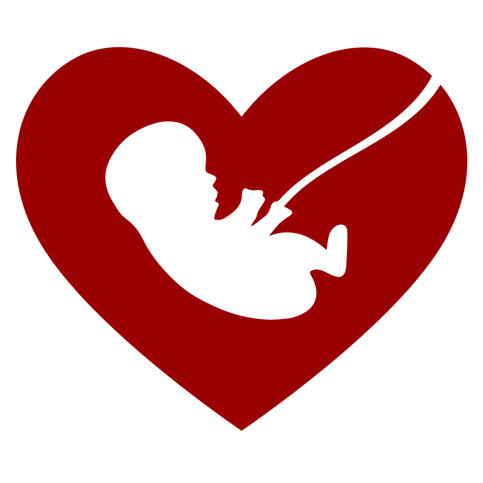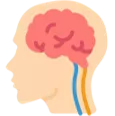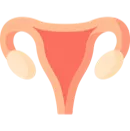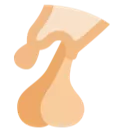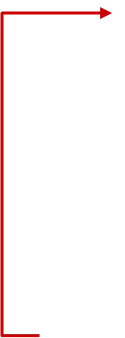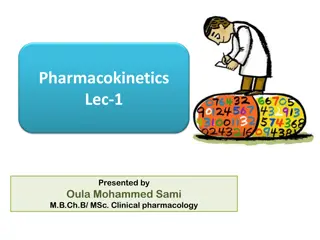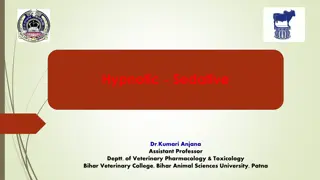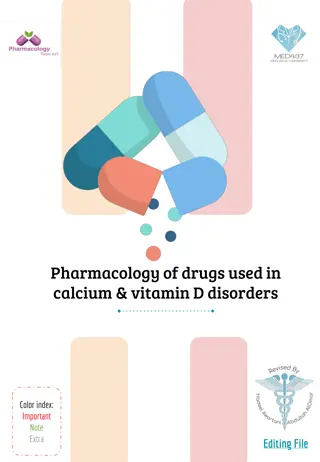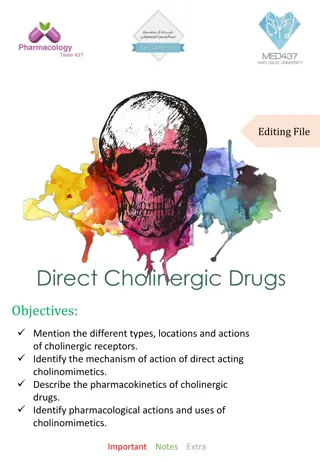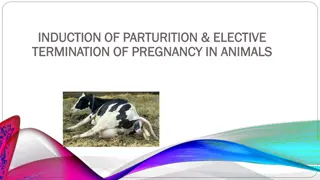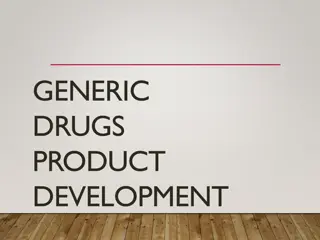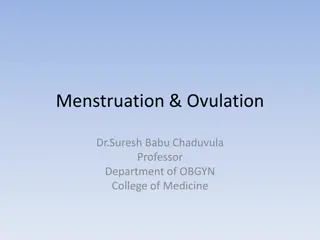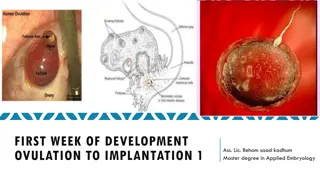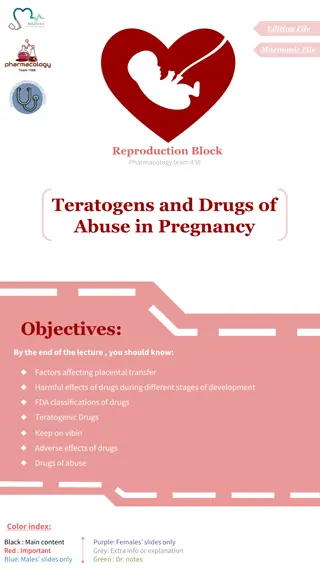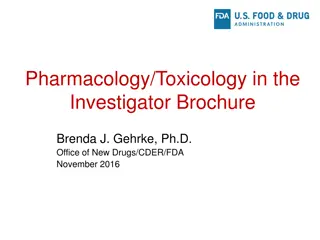Pharmacology of Ovulation-Inducing Drugs
Understanding the mechanism of ovulation and hormonal regulation is key in classifying drugs used to induce ovulation. This lecture covers the pharmacology of different groups of drugs, their mechanisms of action, administration protocols, indications, efficacy rates, and adverse effects. Antiestrogens like Clomiphene and Tamoxifen compete with estrogen, stimulate GnRH, and increase FSH & LH production. GnRH agonists like Leuprolin and Goserelin mimic GnRH activity. These drugs are essential in treating conditions like PCOS and hypothalamic amenorrhea with careful consideration of side effects.
Download Presentation

Please find below an Image/Link to download the presentation.
The content on the website is provided AS IS for your information and personal use only. It may not be sold, licensed, or shared on other websites without obtaining consent from the author.If you encounter any issues during the download, it is possible that the publisher has removed the file from their server.
You are allowed to download the files provided on this website for personal or commercial use, subject to the condition that they are used lawfully. All files are the property of their respective owners.
The content on the website is provided AS IS for your information and personal use only. It may not be sold, licensed, or shared on other websites without obtaining consent from the author.
E N D
Presentation Transcript
Editing File Editing File Mnemonic File Mnemonic File Reproduction Block Pharmacology team 438 Drugs Inducing Ovulation Objectives: By the end of the lecture , you should know: Recall how ovulation occurs and specify its hormonal regulation Classify ovulation inducing drugs in relevance to the existing deficits Expand on the pharmacology of each group with respect to mechanism of action, protocol of administration, indication, efficacy rate and adverse effects Color index: Black : Main content Red : Important Blue: Males slides only Purple: Females slides only Grey: Extra info or explanation Green : Dr. notes
Overview 1. 2. Clomiphene Tamoxifen Antiestrogen (SERMs) Drugs Used to Induce 1. 2. Leuprolin Goserelin GnRH agonists Ovulation 1. 2. HMGs: Menotropin HCGs: Pregnyl Gonadotrophin D2 receptors agonists 1. Bromocriptine PCOS is the most common cause of infertility and insulin resistance may play a role use Metformin, Clomiphene1 Treatment of Polycystic Ovarian Syndrome (PCOS) Hypothalamus Recall Hypothalamic pituitary gonadal axis 1. Hypothalamus secretes Gonadotropin Releasing Hormone (GnRH) to stimulatethe pituitary gland Pituitary gland secretes Luteinizing Hormone (LH) and Follicle stimulating hormone (FSH) which act on ovaries to stimulateit. Ovaries produce estrogen and progestin, they have a -ve feedback on pituitary and hypothalamus It is also important to mention that the prolactin released from the anterior pituitary gland and have an inhibitory effect on GnRH Hyperprolactinemia causes infertility a. The main inhibitor of prolactin is dopamin 2. GnRH 3. Pituitary gland 4. Prolactin LH \ FSH To induce ovulation, there is a need for more LH and FSH. so, drugs act by: Inhibiting the -ve feedback Antiestrogen Stimulating GnRH release GnRH agonists Mimic LH and FSH Gonadotrophs Inhibiting prolactin secretion D2 agonist Ovaries 1. 2. 3. 4. Estrogen \Progestin Special thanks to 436 pharmacology team 1- Clomiphene is 1st choice, if obese or diabetic choose metformin.
1) Antiestrogens Drugs Clomiphene Tamoxifen Compete with estrogen on the hypothalamus and anterior pituitary gland: decrease the negative feedback of endogenous estrogen increase GnRH increase production of FSH & LH ovulation MOA Clomiphene given 50 mg/d for 5 days from 5th day of the cycle to the 10th day. If no response give 100 mg for 5 days again from 5th to 10th day Each dose can be repeated not more than 3 cycles Similar and alternative to clomiphene but differ in being non Steroidal P.K Tamoxifen is a good alternative to clomiphene in women with polycystic ovarian syndrome and clomiphene-resistant cases Used in palliative treatment of estrogen receptor-positive breast cancer(why not Clomiphene?2) Female infertility due to anovulation or oligoovulation1, not due toovarian or pituitary failure (Normogonadotrophic) The success rate for ovulation is 80% & pregnancy is 40% Uses Hyperstimulation of the ovaries and high incidence of multiple birth (75% twins) Hot Flushes & breast tenderness Gastric upset (nausea and vomiting) Visual disturbances (reversible) nervous tension & depression Skin rashes Fatigue Weight gain Hair loss (reversible) ADR - 2) GnRH Agonists Drug Leuprolin & Goserelin MOA Analogous with agonist activity GnRH and agonists, given S.C. in a pulsatile3(1 10 g / 60 120 min as drip) to stimulate gonadotropin release Start from day 2-3 of cycle up to day 10 P.K Induction of ovulation in patients with hypothalamic amenorrhea(GnRH deficient) Given continuously(paroxidal opposite effect )when gonadal suppressionis desirable e.g. precocious puberty and advanced breast cancer in women and prostatic cancer in men Uses GIT disturbances, abdominal pain, nausea...etc Long term use Hypoestrogenism: Hot flashes , libido, osteoporosis, rarely ovarian hyperstimulation (ovarian swelling and enlargement ) Headache ADR 1) Anovulation: failure of the ovary to release an ova. Oligoovulation: irregular ovulation. Because tamoxifen has strong anti-estrogen activity Pulsatile administration stimulates gonadotropin release. Continuous administration suppresses gonadotropin release. 1) 2)
3) Gonadotrophins Drugs Menotropin Pregnyl FSH and LH are naturally produced by the pituitary gland For therapeutic use, extracted forms are available as: MOA Human Menopausal Gonadotrophin (hMG ) extracted from postmenopausal urine contains LH & FSH Human Chorionic Gonadotrophin (hCG) extracted from urine of pregnant women contains mainly LH hMG is given I.M every day starting at day 2-3 of cycle for 10 days followed by hCG on (10th - 12th day)1for ovum retrieval P.K Stimulation & induction of ovulation in infertility secondary to gonadotropin deficiency (pituitary insufficiency) Success rate for inducing ovulation(not fertilization)is usually >75 % Uses FSH containing preparations: Fever Ovarian enlargement (Hyperstimulation) multiple pregnancy ( ~20%) ADR LH containing preparation: Headache edema 4) D2 receptor agonists Drug Bromocriptine Is an ergot derivative (not a hormone) D2 receptors agonists binds to dopamine receptors in the anterior pituitary gland & inhibits prolactin secretion MOA Uses Female infertility secondary to hyperprolactinemia2 GIT disturbances: nausea, vomiting, constipation Headache dizziness & orthostatic hypotension Dry mouth & nasal congestion Insomnia ADR 1) Remember that ovulation occur at day 14 of the cycle, so Pregnyl (which mainly contains LH ) is given between day 10-12 so the body level of LH reaches the optimum level by day 14 to induce a successful ovulation Remember that antipsychotics (anti-schizophrenia) can cause hyperprolactinemia. 2)
Quiz MCQ Q1- A 27-year-old woman with amenorrhea, infertility, and galactorrhea (caused by hyperprolactinemia) was treated with a drug that successful restored ovulation and menstruation. Before being given the drug, the woman was carefully questioned about previous mental health problems, which she did not have. She was advised to take the drug orally. The drug used to treat this patient was probably. A- Bromocriptine. B-Leuprolide. C-Human gonadotropin hormone. D-Clomiphene Q2- A 29-year-old woman has a 3 years history of anovulatory infertility. She has undergone a year of treatment with Clomiphene which was successful. What is the mechanism of action of the drug she was using? A-GnRH Agonist B-Human Chorionic Gonadotrophin C-Antiestrogen D-Dopamine receptor Agonist Q3- A doctor wants to induce ovulation in a woman with hypothalamic amenorrhea. What s the treatment of choice for this condition? A-Continuous Administration of Goserelin B-Tamoxifen pills C-I.M injections of Menotropin D-Pulsatile Administration of Leuprolin Q4- A 31-year-old woman with infertility secondary to pituitary insufficiency is taking gonadotrophins for treatment. Which one of the following is given on (10th -12th day) for Ovum retrieval? A-Bromocriptine B-Pregnyl C-Clomiphene D-Menotropin SAQ - A 23-year-old woman has failed to become pregnant after 2 years of unprotected intercourse. Q1-Which drug would be effective in treating infertility due to anovulatory cycles? Q2-What is the M.O.A of that drug? - A 26-years-old married couple has been unable to conceive after 3 years of unprotected intercourse, the husband s sperms count is normal but the wife labs show infertility is secondary to pituitary insufficiency and they both agree that they would like the wife to undergo fertility treatment. Q3-Which drug can be used in this case? Q4-list 2 ADR of that drug. - A 24-year-old woman with infertility due to hyperprolactinemia and her 29-year-old husband desires to start a family. She is currently taking a fertility medication but is troubled by some side effects. She couldn't sleep at night and she feels dizzy most of the day, and this makes her depressed. Q5-Which drug is she most likely taking? MCQ SAQ Q1 A Q1 clomiphene Q2 C Q2 Compete with estrogen on the hypothalamus and anterior pituitary gland leading to ovulation Answers: Q3 D Q3 Menotropin & Pregnyl Q4 B Q4 Headache -edema - fever Q5 Bromocriptine
Thank you for all the love and support you gave the team in those two years! Hope we made the context much easier to study. God bless you, Future doctors. Team Leaders: May Babaeer Zyad Aldosari This Lecture was Done By: May Babaeer Note writers Nouf AlShammari Quiz writers Noura AlMazrou Shahad AlSahil












